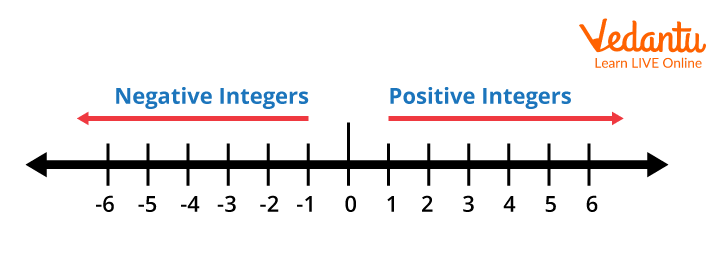




Introduction
The addition between the integers is not completely similar to the addition of natural numbers. At times, when we are asked to add we may have to do subtraction between the given numbers to obtain the result. In case of integer addition, when one of the two integers is negative and the other one is positive in such cases we subtract the numbers and give the sign of the greater number to the result. When the integers carry the same sign, be it positive or negative, we add the integers and give the common sign to the result.
What are Integers?
The Latin term "Integer," which implies entire or whole, is where the word "integer" first appeared. A particular category of numbers called integers includes zero, positive numbers, and negative numbers. Symbol ‘Z’ is generally used to denote integers. Integers are generally represented on a number line. Zero is generally considered as the center of the number line and is neither negative nor positive. The negative numbers are generally placed to the left of zero on the number line while the positive numbers are placed on the right side of 0.

Number Line
Addition of Integers Without Using Number Line
In addition of integers without using a number line, we generally follow basic addition and also subtraction which depends upon the signs of the given integers. Further, we will see the rules of addition of integers without using the number line and thus perform addition between the integers easily and efficiently.
Rules for Addition of Integers (Without Using Number Line) :
If a positive integer is added to a positive integer, both the integers will be added and a positive sign will be attached to the result obtained.
Example :
Add \[( + 7)\] and \[( + 3)\]\[ = 7 + 3 = 10\] i.e \[ + 10\]
Add \[( + 4)\] and \[( + 8)\]\[ = 4 + 8 = 12\] i.e \[ + 12\]
If a negative integer is added to a negative integer, both the numbers will be added and a negative sign will be attached to the result obtained.
Example :
Add \[( - 3)\] and \[( - 7)\]\[ = (-3) + (-7) = (-10)\] i.e \[ - 10\]
Add \[( - 4)\] and \[( - 8)\]\[ = (-4) + (-8) = (-12)\] i.e \[ - 12\]
If a positive integer is added to a negative integer, the smaller one among them will be subtracted from the one which is greater and the sign of the greater integer will be attached to the result obtained.
Example :
Add \[( +7)\] and \[( - 3)\]
Here, 7 is greater and 3 is smaller. Therefore, \[ 7 - 3 = 4\]
The sign of the greater number is positive so the result will also be positive i.e.\[ + 4\]
Add \[( +3)\] and \[( - 8)\]
Here, 8 is greater and 3 is smaller. Therefore, \[ 8 - 3 = 5\]
The sign of the greater number is negative so the result will also be negative i.e.\[ - 5\]
Solved Examples :
Evaluate : \[( - 4)+( - 5)\]
Solution : Here, as we can observe that the integers to be added have the same sign i.e both the integers are negative .
So, as per the rules for addition, we add them and the common sign is attached to the result.
Therefore, \[(- 4)+ ( -5)= -( 4 + 5) = - 9\]
Evaluate : \[(- 13) + (+ 17)\]
Solution : Here, as we can observe that the integers to be added have the opposite sign i.e. one is negative and the other is positive .
So, as per the rules for addition, we subtract the smaller number from the greater one and then the sign of the greater integer is attached to the result.
Here, 17 is the greater number.
So, \[17 - 13 = 4\]
As the greater number is positive, the result will also be positive.
Therefore, \[(- 13) + (+ 17)= + 4\]
Evaluate : \[(+ 14) + (+ 15)\]
Solution : Here, as we can observe that the integers to be added have the same sign i.e both the integers are positive .
So, as per the rules for addition, we add them and the common sign is attached to the result.
Therefore,\[(+ 14)+ ( +15)= 14 + 15 = 29\]
Conclusion :
Thus, we can observe that while adding the integers manually without using a number line, we generally add the ones with common sign and give the common sign to the result obtained. In case of opposite signs, we subtract the smaller one from the greater one and the sign of the greater one is attached to the result obtained.
FAQs on Add Without Using Number Line
1. What happens when zero is added to any negative integer?
In this case, the result of the addition will be the negative number itself similar to the way we add zero to the natural numbers and the result remains the number itself.
E.g.\[(- 4)+ 0= = - 4\]
2. When is addition of integers without using a number line helpful?
Addition of integers without using a number line is very helpful when the integer to be added is too large to be plotted on a number line in the book.
3. What is an additive inverse of a number?
The additive inverse of a number is the same number with opposite sign . So, if the number is positive the additive inverse will be negative and vice versa.
E.g. a. The additive inverse of \[- 5 \] is 5
b. The additive inverse of 7 is \[- 7 \]
4. What is the sum of the number and its additive inverse?
The sum of a number and its additive inverse is 0.
E.g. \[(- 3)+ 3 = 0\]











